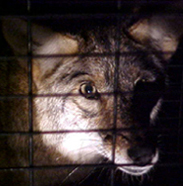
Captured Coyote
|
Coyotes
Coyotes
are one of the major wildlife success stories of the Western
Hemisphere. Once unknown east of the Mississippi
River,
they can now be found throughout the continental United States. From
Alaska to Panama, from the Pacific Ocean to the Atlantic,
coyotes
have proven their adaptability to a wide range of habitats.
In
some areas, this was achieved after humans exterminated wolves, which
were lethal predators of their smaller cousins.
Coyotes
are doglike in appearance. They stand about 2 feet tall at
the
shoulder, weigh between 20 and 50 pounds and generally average 3.5 to
4.5 feet long, including a brushy tail. Northern
and
eastern coyotes are often much larger than their desert
counterparts. These wild canids have sharp pointed noses,
erect
pointed ears, and hold their tail downward when they are
running.
The fur on their upper parts is
usually a dull
yellow-brown with grizzled black markings down the back. The
belly area may be pale cream colored. Vocalizations
include
howls, yips, and barks and have been found to comprise a communication
“language”.
Coyotes have well-developed
senses of hearing and smelling. They are
intelligent,
omnivorous, monogamous, and prolific. Breeding season runs
from
January to March and pups are born following a two-month
gestation period. A birthing den could be a burrow,
rock
cave, hollow log, or shelter under a manmade structure.
Litter
sizes usually include 5 to 10 young, although numbers twice
as
high have been recorded.
More pups are
born when coyote
densities are low and food supplies are high. Both adults
care
for and train their offspring. A coyote’s diet includes
everything from insects, reptiles, birds, and mammals to fruits, nuts,
berries, and carrion. They hunt alone or in family groups and
can
sprint 40 miles an hour to catch a jackrabbit or use teamwork
to
capture a deer. Hunting and foraging territories are quite
large,
often ten square miles in size, and are protected from competitors as
much as possible. This is one reason why fox
populations
tend to decline when coyotes are present in high numbers.
Like
all predators, coyotes are opportunistic hunters and
scavengers. Proximity to humans in urban, suburban
or rural
settings offers a whole new menu for them. Garbage, dog food
left
outside, vegetables from gardens, poultry, and smaller
livestock
like calves, sheep, and goats have all been consumed with great
regularity. Click
here for Page 2 |